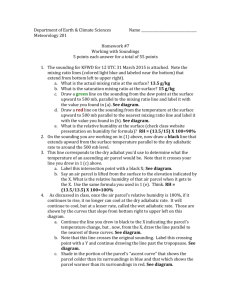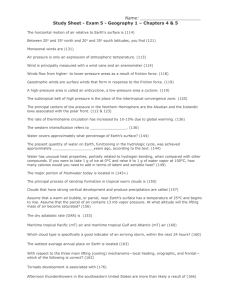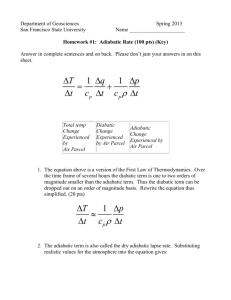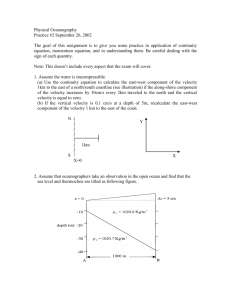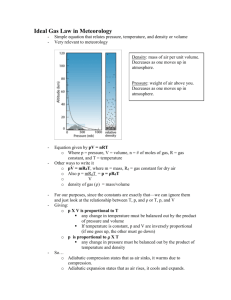Adiabatic lapse rate
advertisement
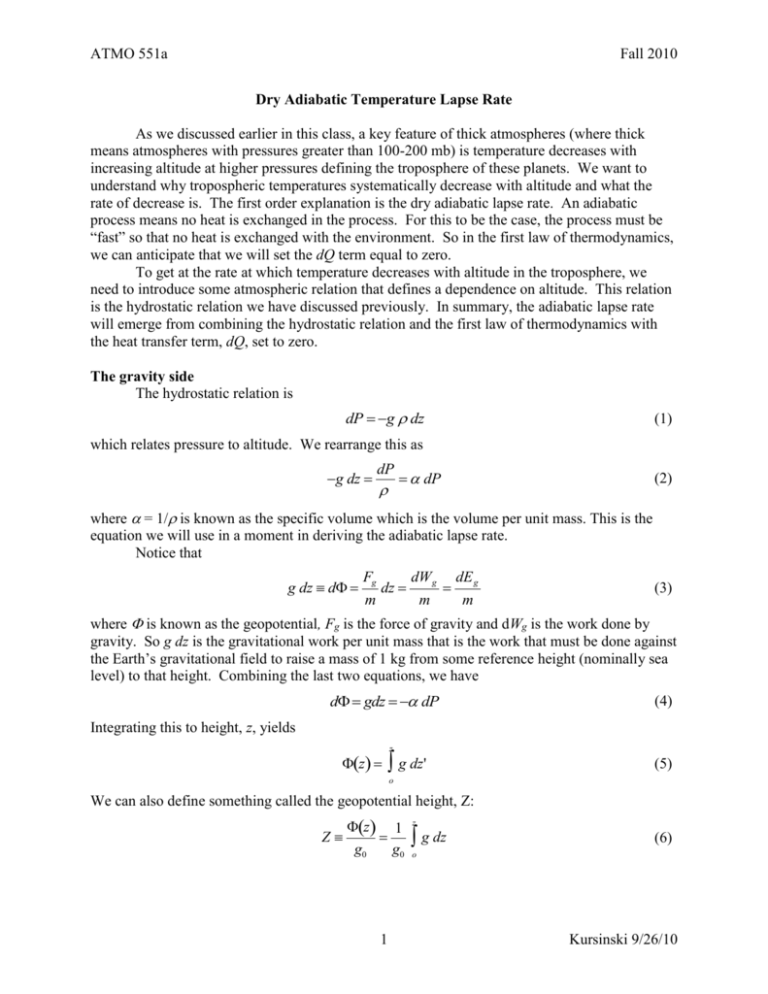
ATMO 551a Fall 2010 Dry Adiabatic Temperature Lapse Rate As we discussed earlier in this class, a key feature of thick atmospheres (where thick means atmospheres with pressures greater than 100-200 mb) is temperature decreases with increasing altitude at higher pressures defining the troposphere of these planets. We want to understand why tropospheric temperatures systematically decrease with altitude and what the rate of decrease is. The first order explanation is the dry adiabatic lapse rate. An adiabatic process means no heat is exchanged in the process. For this to be the case, the process must be “fast” so that no heat is exchanged with the environment. So in the first law of thermodynamics, we can anticipate that we will set the dQ term equal to zero. To get at the rate at which temperature decreases with altitude in the troposphere, we need to introduce some atmospheric relation that defines a dependence on altitude. This relation is the hydrostatic relation we have discussed previously. In summary, the adiabatic lapse rate will emerge from combining the hydrostatic relation and the first law of thermodynamics with the heat transfer term, dQ, set to zero. The gravity side The hydrostatic relation is dP g dz (1) which relates pressure to altitude. We rearrange this as g dz dP dP (2) where = 1/ is known as the specific volume which is the volume per unit mass. This is the equation we will use in a moment in deriving the adiabatic lapse rate. Notice that F dW g dE g (3) g dz d g dz m m m where is known as the geopotential, Fg is the force of gravity and dWg is the work done by gravity. So g dz is the gravitational work per unit mass that is the work that must be done against the Earth’s gravitational field to raise a mass of 1 kg from some reference height (nominally sea level) to that height. Combining the last two equations, we have d gdz dP (4) Integrating this to height, z, yields z z g dz' (5) o We can also define something called the geopotential height, Z: Z z 1 g0 g0 z g dz (6) o 1 Kursinski 9/26/10 ATMO 551a Fall 2010 where g0 is the globally averaged acceleration due to gravity at the Earth surface normally taken as 9.81 m/s2. Z is often used as a vertical coordinate either independent so that P(Z) or dependent, Z(P). The Thermodynamics side We return to the first law of thermodynamics dQ + dW = dU + dEB (7) When we change the altitude of an air parcel, there are two energy transfers involving work, One associated with doing work to raise the air parcel in Earth’s gravity field which changes the bulk potential energy. the work associated with the air parcel decompression as the air parcel is raised to higher altitude and lower pressure. In the first type of work, remember that the vertical force on an air parcel that is not moving vertically is zero and in hydrostatic balance. To move the parcel vertically means the vertical force balance of gravity and pressure is no longer exactly zero such that the air parcel accelerates vertically. In this case, there is some work transferring energy to the bulk energy of the air parcel. While this is necessary to move the air parcel vertically, this is not the energy transfer we are interested in right now. We are interested in the second type of work associated with the change in pressure as the air parcel is lifted (or lowered). We assume the lifting is fast enough that there is no heat transfer to or from the air parcel. In this case, dW = dU (8) Substituting for both the work and the internal energy terms, we get -P dV = m Cv dT (9) where m is the mass of the air parcel. Using d(PV) = P dV + V dP, we get V dP - d(PV) = m Cv dT (10) From the ideal gas law, PV = nR*T. Therefore V dP - d(nR*T) = V dP - nR*dT = m Cv dT (11) In this case, n is the number of moles in the air parcel with volume, V, and the mass of the air parcel is given by m = n where is the mean molecular mass per mole of the gas molecules in the parcel. Dividing through by the mass of the air parcel yields V n dP R * dT Cv dT m m 1 n R* dP R * dT dP dT Cv dT n R * dP Cv dT C p dT (12) (13) 2 Kursinski 9/26/10 ATMO 551a Fall 2010 Combining (13) with either equation (2) or (4) from the gravity and geopotential derivation above, yields g dz C p dT (14) dT g dz Cp (15) So This is general, true for any planetary atmosphere. For Earth, the heat capacity at constant pressure of air is approximately 1000 J/kg/K (you have a homework assignment on this). The average gravitational acceleration at Earth’s surface is 9.81 m/s2. So the dry adiabatic vertical temperature gradient is about -9.8 K/km. The dry adiabatic lapse rate (defined as – dT/dz) is about +9.8 K/km. The dry adiabatic temperature lapse rate is the temperature change with altitude when the atmosphere is rapidly overturning. The figure below provides an example. This figure above is a “skew T” plot of the Tucson radiosonde profile taken on Sept 22 at 00 UTC in 2008 which is Sept 21, 5 PM local time. Plotted on the figure are the temperature profile 3 Kursinski 9/26/10 ATMO 551a Fall 2010 (the thick solid white line), the dew point temperature profile (the thick green dashed line) which provides a measure of the vertical profile of water vapor and the wind profile which is the sequence of arrows along the right hand edge of the figure. The thin solid white lines tilted to the right are lines of constant temperature. This tilt is to compensate for the fact that temperature generally decreases with altitude in the troposphere. The solid yellow lines that tilt to the left represent dry adiabats, which we are discussing at present. The dashed yellow lines that start out somewhat vertical near the surface and then tilt to the left at higher altitude (lower pressure) are moist adiabats. The moist adiabat includes the effect of the latent heat release as water condenses out. The temperature profile shows the interval between the surface and about 600 mb follows a dry adiabat or adiabatic temperature profile almost perfectly. This is an indicator of a deep, dry convective boundary layer in which the air is rapidly overturning, in this case due to heating from the very hot surface below in our semi-arid region. Dry Adiabatic Temperature vs. Pressure and Potential Temperature In equation (15) above, we determined the dry adiabatic lapse rate as a function of altitude. We will now derive the temperature dependence on pressure for a dry adiabatic lifting or sinking process. Starting with (12) from above 1 dP n R* R * dT dP dT Cv dT n (12) R * dP Cv dT CP dT 1 (16) R * T From the ideal gas law, P , so P (17) R*T expression for density into (16) yields Substituting this dP dP R * T P C p dT We integrate this dP C p dT P R* T C p C ' d ln P d ln T p d ln T R* R* (18) (19) T1 P1 Cp ' C p ' T1 C ' T d ln P ln P1 ln P0 lnP R * d ln T R * d ln T Rp* lnT1 0 0 P0 T0 T0 P1 Taking exp() of both sides and using the fact that exp(a ln[x]) = xa, yields 4 Kursinski 9/26/10 ATMO 551a Fall 2010 Cp ' P1 T1 R* P0 T0 (20) This shows there is a power law relation between pressure and temperature under dry adiabatic conditions. Note I have chosen to write the equations in terms of Cp’/R* (the molar form) rather than Cp/R, where R=R*/, because the relation is more obvious because Cp’ in Earth’s atmosphere is about 7/2 R*. Therefore Cp’/R* is quite close to 7/2. Now we rearrange (20) to obtain the dependence of temperature on pressure which is what we really want. R* Cp ' R Cp P P T1P1 T0 P0 1 T0 P0 1 P0 P0 (21) I have written T1 as T1 (P1) to make it clear that T1 is the atmospheric temperature at pressure = P1. Note that R*/Cp’ is quite close to 1/(7/2) = 2/7. Alternatively we can rewrite (21) as R R* P C p P C p ' T0 T1 0 T1 0 P1 P1 (22) where is known as the potential temperature. (22) tells us that given air with a temperature of T1, at pressure, P1, the temperature of that air parcel would be if the air parcel were moved adiabatically to another pressure, P0. On Earth, potential temperature is defined with P0 taken to be the average sea level pressure, 1013 mb. Note that a powerful feature of the potential temperature of an air parcel is that it is conserved under adiabatic lifting or sinking motion. As a result, is very useful for determining the vertical stability of the air, that is its likelihood of overturning. Potential temperature can be used as a vertical coordinate as long as the air is somewhat “stable”, that is temperature does not decrease with altitude as fast as the dry adiabatic lapse rate. Stable vs. neutral vs. unstable The potential temperature provides a way of determining atmospheric stability, that is whether or not hot air rises and cold air sinks. The adiabatic lapse rate defines how the temperature of an air parcel will change when it is displaced. What is important is the vertical temperature structure of the environment relative to an adiabatic lapse rate. If the environmental temperature decreases more slowly with increasing altitude Stable (unstable) means the potential temperature of the environmental air column increases (decreases) with altitude. Neutral stability conditions occur when the potential temperature is constant with altitude which is usually the sign of active dry convection d/dz > 0 stable d/dz = 0 neutral d/dz < 0 unstable We’ll draw some figures in class to go over this. 5 Kursinski 9/26/10 ATMO 551a Fall 2010 The oscillation frequency of displaced air parcels Consider the force on a displaced air parcel. Its pressure is the same as the rest of the air at that altitude because pressure adjusts at the speed of sound which is much faster than the vertical velocity of the air parcel’s displacement. However, the vertically displaced air parcel’s temperature differs from that of the surrounding air. Therefore its density differs from that of the surrounding air. Therefore the gravitational force on the air parcel differs from that on the surrounding air. Therefore the air parcel is no longer in hydrostatic balance and there is a net vertical force on it and it will begin to accelerate vertically. The net vertical force on the air parcel is the difference between the gravitational force on it and the surrounding air (which is in hydrostatic equilibrium). Therefore Fvert = g parcelenvV = g V (23) where V is the parcel volume. The density difference is parcel env P 1 1 P Tenv Tparcel R * Tparcel Tenv R * TparcelTenv Tenv Tparcel Tenv Tparcel parcel R * Tparcel Tenv Tenv (24) F gV g m parcelV parcel (25) P The mass of the air parcel is parcel V so the vertical acceleration of the air parcel is a The fractional density difference between the air parcel and the environment is parcel T parcel env T parcel env parcel Tenv (26) The temperature of the parcel rapidly displaced vertically by a small amount from z0 to z is given by T (27) Tparcel z T z0 z z0 z adiabatic The temperature of the environment is given by Tenv z T z0 z z0 T z env (28) So the temperature difference between the displaced air parcel and the surrounding environmental air is T T Tparcel z Tenv z z z0 z adiabatic z env parcel T T z z0 T T parcel env Tenv z adiabatic z env Tenv 6 (29) Kursinski 9/26/10 ATMO 551a Fall 2010 So the vertical acceleration of the air parcel is g parcel g T T z z0 Tenv z adiabatic z env (30) This can be expressed more compactly using the potential temperature. R R* P0 C p P0 C p ' T0 T1 T1 P1 P1 (22) R R Cp Cp P P 0 T 0 R R R 1 P1 C P1 P Cp R P0 p T1 P0 C p T1 1 C p T1 T1 P0 z z z z P1 z P1 z R R R R R 1 P P C p T P0 C p R 1 P1 R P0 C p T1 1 0 1 Cp T1P0 C p P T 1 1 C z P1 z z P1 z P1 C p P1 z p but d ln(P)/dz = -1/H = g/RT so R R p p P C P0 C T1 T1 0 z P1 z P1 R R g P C p T g 0 1 C RT P 1 z C p p (31) We divide through by to get R P0 C p T1 g T g g T1 Tadiabatic T1 1 P1 z C p z C p C p z z z R z T1 T1 T1 P0 C p T1 P1 (32) Combining this with the equation above yields g parcel g T T g z z0 z z0 Tenv z adiabatic z env z (33) Notice the parcel’s vertical acceleration has the form of the simple harmonic oscillator (SHO), F/m = a =-k/m x where k g m z (34) The frequency of a SHO is derived as follows d2x F ma m 2 kx dt 7 (35) Kursinski 9/26/10 ATMO 551a Fall 2010 a d2x k x 2 dt m (36) Taking the solution to be sinusoidal: x(t) = X sin(t + ) then dx X cost dt d2x k 2 X sin t 2 x x (37) 2 dt m Therefore the oscillator frequency in radians per second is (k/m)1/2. So the frequency of the oscillation of a displaced air parcel is g 1/ 2 N z (38) This is known as the Brunt-Vaisala frequency. The more stable the air is, that is the larger d/dz, the strong the restoring force to displaced air parcels and the faster they oscillate. Notice also that the acceleration is proportional to N2. 8 Kursinski 9/26/10 ATMO 551a Fall 2010 Temperature related climatology figures from Peixoto and Oort (2002) 9 Kursinski 9/26/10 ATMO 551a Fall 2010 January minus July average surface temperatures 10 Kursinski 9/26/10 ATMO 551a Fall 2010 11 Kursinski 9/26/10 ATMO 551a Fall 2010 Diurnal cycle on Mars 12 Kursinski 9/26/10


